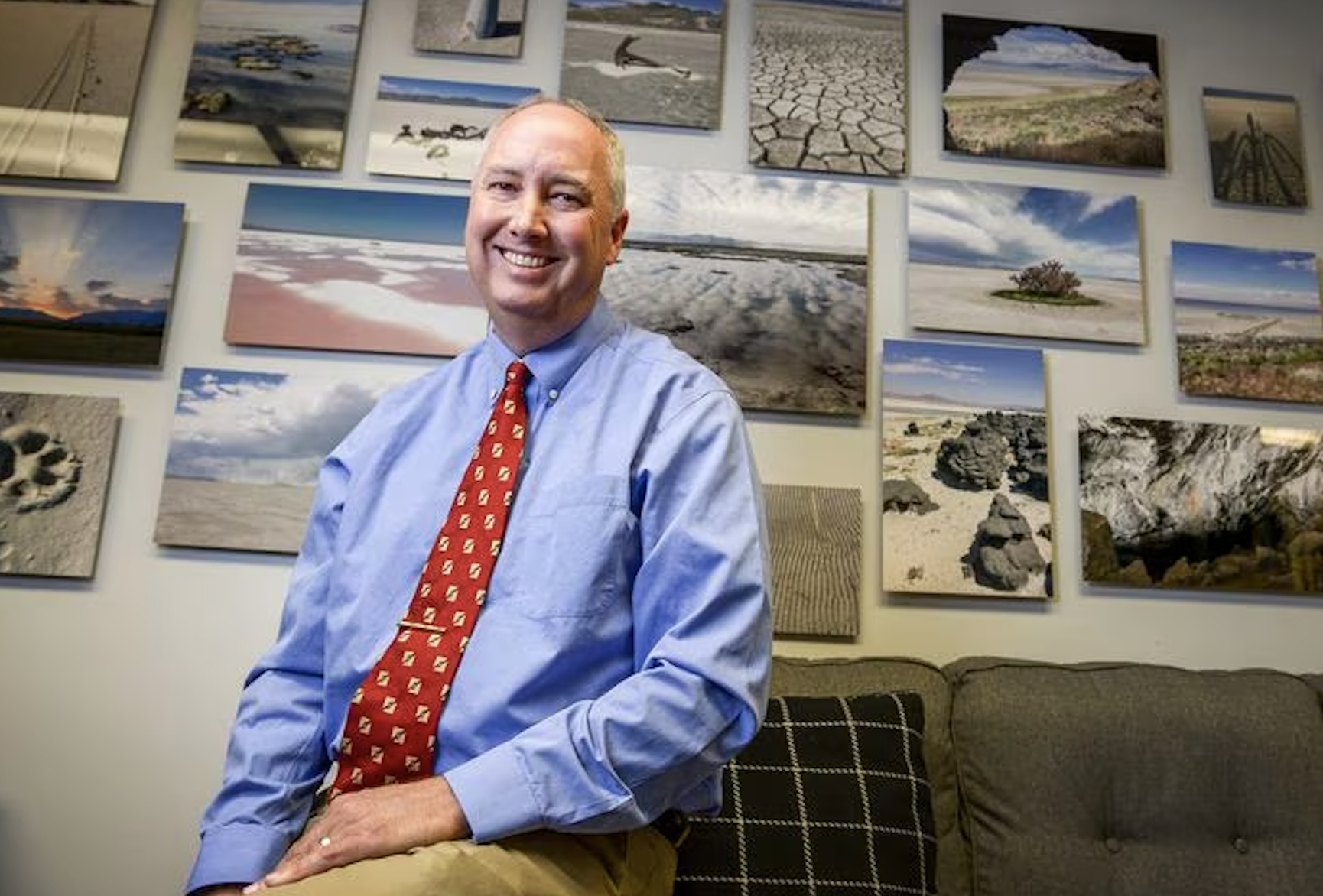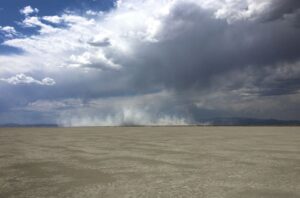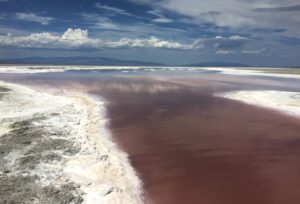
Dr. Kevin Perry has been studying air quality for over 20 years. Perry has monitored plumes from the World Trade Center collapse, smoke from pyrotechnic – firework – displays, and more recently he has been studying dust blowing off the Great Salt Lake. He has deployed equipment to monitor ambient air from the ground, from ships, from the sky, and from high-altitude mountain observatories around the world. Perry recently explored 800 square miles of Great Salt Lake lakebed over two years, on his bicycle. This added to his previous work of trying to understand how mercury is transported in the air, and how bad air quality can impact birth outcomes. He previously served as chair of the Department of Atmospheric Sciences at the U, and currently teaches atmospheric sciences courses on air quality, health, and society. (Featured photo courtesy of Leah Hogsten, Salt Lake Tribune)
Listen to the interview
Transcript

Ross 1:15
So, the Great Salt Lake and dust concerns is an issue that you’ve been paying attention to with respect to changing climate and impacts, health impacts for probably a lot longer than most people. So, what drove you to start paying attention to this and want to research it?
Kevin Perry 1:39
Yeah. So I’ve been studying dust in the atmosphere for almost 30 years. I used to work for the National Park Service a long time ago, and we were seeing dust coming into the eastern part of the United States during the summer, and we had no idea where it was coming from. And so we did chemical measurements and we’re able to trace it back to dust that was coming off the African continent and moving all the way across the Atlantic and into the eastern U.S. And we found that there was more dust in Texas from Africa in July than from North America. And that kind of got me going on my dust odyssey. And a little more than ten years ago, I started noticing dust plumes coming off the Great Salt Lake. And I’m well aware of other terminal basin lakes in the world that have been drying up and the dust problems that they’ve been associated with that. And so I knew it was an area that I could contribute to.
Ross 2:28
So, when you were out exploring those, you know, almost 800 square miles of the Great Salt Lake playa on your bicycle, what was it like to be out there all by yourself?

Kevin Perry 2:42
Very lonely, introspective and absolutely magical. I went out to the Great Salt Lake more than 150 times over that two year period to, you know, take soil samples and to learn more about the surface crust and the conditions out there. And I was really surprised that every single time I went out, I saw something new and different and just the incredible variety of wildlife and geological features and, you know, opportunities for recreation, it just never ceases to amaze me that this was in our backyard. And yet most people never explore it.
Ross 3:19
Well, just to stay with that a little bit, I’m just curious, like what what kind of observations did you take away? Like, you know, what did it feel like? What did it sound like? What did it smell like? Those kind of things.
Kevin Perry 3:31
So, the Great Salt Lake is a very large area and every spot on the lake is very different. So when you get into the water areas, you have a lot more wildlife and you hear the birds, you know, from the cacophony of the sounds of the birds, and you start to get into some interesting smells. You know, when you are in those wetland areas, the dry areas can be vast and lonely on some days you can have a cloud of bugs that just follow you around and it’s just, you know, a visceral experience that been out there, you know, when it was over 100 degrees, you know, and I’ve been out there when it’s below freezing, you know, just and just the variety of the experience is pretty amazing. And then you get to different places, very unusual places that very few people get to visit. And you see some very magical things. For example, one day I was up on the northern part of the lake and it had been a wind storm the day before. And I went out to the shore of the lake and there was foam everywhere five feet deep. And it’s just like I never expected to see foam coming off the Great Salt Lake and you can just walk through it. I didn’t, but you could have and just, you know, crazy things like that.

Ross 4:50
I know you’ve given a number of talks on your research and your findings with regard to dust and what what’s in the dust and and the degree of risk or uncertainty about health risks from from breathing it in. And I’m just wondering, what was your main takeaways from that, from the research you’ve done up until now as far as what we should be paying attention to with regard to the lake?
Kevin Perry 5:20
So when it comes to dust from any source, regardless of whether it’s from the lake or from activities that we have here in the city, when the particle concentrations are high enough, they cause inflammation of the lungs. And for certain people that can actually cause respiratory distress. And it doesn’t matter what the particles are made out of, it’s just the concentration impacts, their ability to breathe and so the plumes coming off of the Great Salt Lake are high enough in concentration at times to where they could cause respiratory distress in people downwind and in addition to that, I also discovered that there were very high concentrations of certain metals in the dust that are carcinogens. The one that I’m most concerned about is arsenic. Every single measurement of the soil that I took around the Great Salt Lake had arsenic concentrations that were more than a factor of ten higher than what would be recommended by the EPA for routine exposure and long term exposure to arsenic in the dust could theoretically lead to increases in the rate of lung cancer and skin cancer and bladder cancer.
Ross 6:30
Well, I know you said that there is an ongoing need to keep researching this and understand the health risks. What what where specifically do you feel like more ongoing research needs to happen?
Kevin Perry 6:46
So we know that the dust comes off of the lake bed, but surprisingly, we don’t know how often and how severe those storms actually are because we don’t have a well-designed network that’s specific. We designed to measure the dust coming off the lake. So that’s the basic fundamental question that we’re trying to answer, is how frequently are people exposed to the dust and then once you find out how frequently people are exposed, then you have to do more detailed research on the metals that are in the dust to find out if they’re bioavailable. Will they be absorbed by your body or are they locked up in minerals that don’t interact with your body and therefore don’t pose a risk? So when it comes to these metals, including arsenic, I label them as contaminants of potential concern that we need to do our research on to figure out, you know, what are the exposure levels that people are experiencing and, you know, what are the potential health outcomes of that.
Ross 7:44
I see. And what kind of response have you gotten from your research? I mean, do you feel like current public awareness or or policy actions are happening in reaction to what you’ve learned?

Kevin Perry 7:56
So when I finished my soil survey in 2018 and started writing up the results, I was really pessimistic about the future of the Great Salt Lake and the dust problems that would ensue because most people didn’t even realize the Great Salt Lake was shrinking and fewer people still understood the potential economic or ecological or health problems associated with that. So I decided to embark on a different kind of journey for a scientist, which was educational outreach and talking to the public of every venue that I could possibly get to. I volunteered to try and spread the word, to increase people’s level of understanding. And I wasn’t the only scientist that was doing this. There was a small group of us, and within a few years, the change has been dramatic. Now, when I talk to people on the street, they understand that the Great Salt Lake is shrinking. They understand that it poses risks to the residents of northern Utah and they want to do something about it. And their collective voice has been heard by the state legislators. And there are several key legislators who have staked their political reputation on saving the Great Salt Lake, most notably the Speaker of the House, Brad Wilson, and the legislature over the last two years has made the most sweeping changes to water law in the last hundred years, trying to remove barriers that would prevent water from getting to the Great Salt Lake, and then they spent the last year trying to incentivize conservation so that we can actually end up putting more water back in the lake and save this magical ecosystem.
Ross 9:33
Do you do you think that we, at least within the scientific community or the atmospheric sciences community, those who study air pollution, do you think we have a just a better understanding of how air pollution operates or how it can impact human health more than we did like, say, 20 years ago?
Kevin Perry 9:53
So, the science is moving forward at a slow pace because the interactions of pollutants and the human body is exceedingly complicated. It involves not only personal exposure, but gene expression from individuals, preexisting conditions. All of those things make it really difficult to study. But Utah is perhaps the best place in the world to actually study this. We have this wonderful health care system that keeps track of all of the health outcomes and make that available for researchers so we can combine the air quality data with the health outcome data to try and look for correlations and see what the impact of these pollutants might be on human health. But the public certainly has become much more aware of the linkages between air quality and health over the last 20 years, in part due to other researchers and other scientists and other physicians that have taken it upon them to spread the word on those linkages.
Ross 11:03
And with regarding to the efforts to mitigate dust pollution coming off the lake, what would you say are probably the top policy actions that perhaps we could take to do that?

Kevin Perry 11:19
The best thing for understanding how we might mitigate the dust is to look at what other people have done in other regions around the world and the poster child for this is Owens Dry Lake in California. Oh, it’s dry. Owens Lake was a freshwater lake about 1/10 the size of Great Salt Lake. 100 years ago. And Los Angeles diverted all of the water for drinking in the city of Los Angeles, and the lake completely dried up over a period of a decade. And it became the largest dust source in North America and started impacting people’s health, who lived downwind and eventually the U.S.. In fact, the Environmental Protection Agency put that area of California out of compliance for air quality conditions, and the city of Los Angeles was forced to try and mitigate the dust. And they tried everything. They put up snow fences to slow the wind down. They went out with farm equipment to tell the surface to make it rough. They put in berms and tried drip irrigation. They even crushed up gravel and covered, you know, a few square miles of gravel. And they spent two and a half billion dollars with a “B,” trying to mitigate the dust. And you know what they learned? The best way to mitigate the dust is to cover it up with water.
And so, what they’ve done now is they’ve gone out and they’ve leveled the lake bed, and they now flooded with two or three inches of water to try and keep the dust under control. And they’ve reduced the dust emissions by about 99 and a half percent at great cost. And it’s still one of the largest dust sources in North America despite all of these efforts. So when it comes to the Great Salt Lake, which is 10 to 12 times bigger than Owens Lake, there is no dust mitigation technique that you could do that wouldn’t cost $50 billion. So what we have to do is we have to focus in on putting water back in the lake, which will have the other benefits of saving the ecosystem.
Ross 13:25
I see. Well, just just a couple more questions for you. And this one is more, I guess a little more maybe perhaps introspective. What sort of impact, if you look at your your long career as an atmospheric scientist, what sort of impact do you hope that your work will have on the world, on society at large?

Kevin Perry 13:47
So, one of the reasons I became an atmospheric scientist and specifically to study air quality is because I wanted to do something that actually matters that can, you know, protect people’s health. And I’ve done a lot of smaller things along the way, which I think have raised awareness about this issue. But if I look back and we’re able to actually save the Great Salt Lake and I played some small part in that, that would be really fulfilling personally.
Ross 14:15
Well, and then final question. When you’re not doing research, what do you do? What do you do for fun?
Kevin Perry 14:23
I absolutely love the Western U.S.. I grew up in Kansas where there were no mountains at all. And so when I moved out west for the first time, I was just mesmerized. And so any chance I get, I’m out hiking or or skiing. And I really enjoy the mountains. I also really enjoy the desert areas as well, because they have equally interesting the different, you know, experiences that you can have in those regions as well.
Ross 14:52
Yeah, great. Well, Dr. Kevin Perry, thank you so much.
Kevin Perry 14:56
Thank you for having me again here.
Relevant Research and Articles:
https://www.sltrib.com/news/environment/2019/09/16/u-scientist-goes-extra/